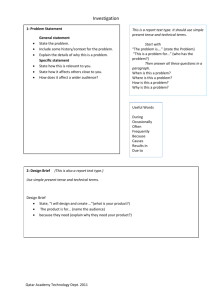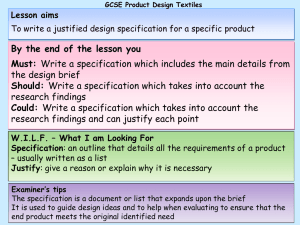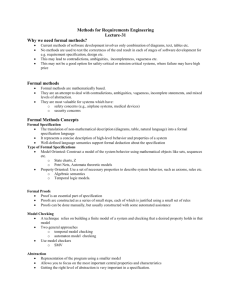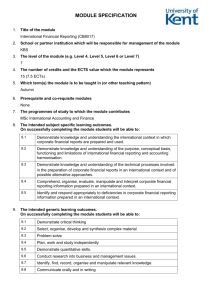Standards Research
advertisement
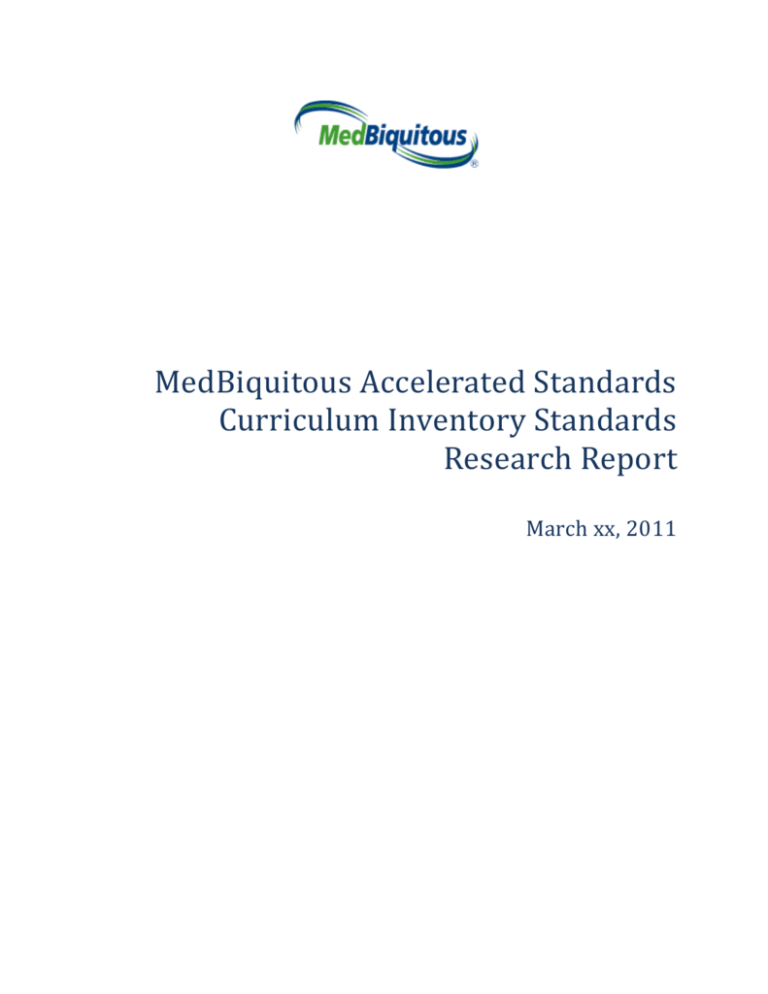
MedBiquitous Accelerated Standards Curriculum Inventory Standards Research Report March xx, 2011 Contents Introduction .............................................................................................................................................. 3 Organizations Researched ........................................................................................................................ 3 Findings ..................................................................................................................................................... 3 Existing standards, specifications, and open systems .......................................................................... 4 Best Practices ........................................................................................................................................ 9 Controlled Vocabularies ........................................................................................................................ 9 Use of Competencies .......................................................................................................................... 10 Introduction As part of the standards development process within the Curriculum Inventory Working Group, MedBiquitous has researched existing standards and specifications that could be assets in the development of a curriculum inventory specification. As a matter of best practice, MedBiquitous build on existing standards when it is practical to do so. MedBiquitous staff researched credible learning technology standards developers and relevant open tools. A summary of the findings for each standard or specification researched is included along with information on relevant vocabularies, best practices, and recommendations on the use of competencies. Organizations Researched The following organizations were researched: CEN (The European Committee for Standardization) CurrMIT IEEE Learning Technologies Standards Committee (IEEE LTSC) IMS Global Learning The UK Joint Information Systems Committee (JISC) LAMS The Post Secondary Education Standards Council (PESC) University of Edinburgh Within each organization, a search for curriculum related standards, specifications, and systems was conducted. Findings The European Standardization group CEN has produced a specification for the representation of curricular information. The Curriculum Exchange Format was approved as a CEN Workshop Agreement January 2010; it is unclear as to whether any software developers in Europe have implemented the standard. CEN has also produced Metadata for Learning Opportunities, which has been refined to support curriculum in the ECTS Information Package/Course Catalogue. Again, adoption rates are unclear. JISC has assembled other standards and specifications to produce the dynamic learning maps application. JISC has also funded the development of eXchanging Course Related Information - Course Advertising Profile, a specification which formed the basis of Metadata for Learning Opportunities and has since evolved to become a profile of that standard. In addition, other standards and specification developers have some work related to curriculum representation. If the MedBiquitous Curriculum Inventory Working Group is to leverage any of these specifications, we must take into account the following: Any licensing or Intellectual Property policies of the parent organization and their approach to derivitative works made by external organizations. The ability to extend the specification. None of the works cited address the US continuing education or residency environments, so a mechanism for extension suitable to including that data would be necessary. Technical constraints and tradeoffs. In some cases very general approaches to representation are used. Overgeneralization can make adaptation to a particular domain difficult if the mappings to that domain are not clear to implementers. Or sometimes older technologies are used where newer technologies are available. Adoption. If an existing specification has broad adoption and is highly applicable, leveraging that specification would increase the scope of interoperability and increase chances for broader adoption. Existing standards, specifications, and open systems AAMC CurrMIT www.aamc.org/currmit There is a technical specification for the CurrMIT system that enables systems to export data in a format that can be uploaded or transferred to the system. The group has already determined that many aspects of this specification are too constraining. We should keep in mind the lessons learned from CurrMIT as we go about building or building on a specification. Some oft cited lessons include: Controlled vocabularies are necessary to promote usability. Certain fields overlapped in practice(ie categories and keywords), resulting in duplicative entries and difficulty using the fields as they were intended. There is a need to move beyond the notion of a course and to represent programs, tracks, and themes. Incorporating the concept of an academic year could be beneficial. Schools use various units of time as the major organizing principle for their curricula (year, 18 month block, etc) Many schools offer some integration of basic and clinical sciences as well as interprofessional education and longitudinal clerkships, and these are difficult to capture. Clerkships need to be clearly identified as such. It’s essential to map competencies to program and course objectives. CEN CWA 16078:2010 Curriculum Exchange Format http://esearch.cen.eu/Details.aspx?id=4011322 “Learning resources can be found on the Internet or in a computer system. They are often stored in an organised way in repositories together with information about them. The information is called metadata and it helps to search, browse, filter and then retrieve additional information. Some of the keywords that are put into metadata can be based on words or phrases taken from real curricula so that learners and teachers can relate to them. Adding the identifiers of these terms or concepts to metadata and associating them with a resource, is called tagging. Curricula often have a tree like structure that presents topics and objectives in a particular way. This structure can be used to navigate or browse to the terms that are used in the metadata and so provide links to useful resources. The main benefit that will result from widespread use of the Curriculum Exchange Format (CEF) will be that learners and teachers will be able to find resources using a curriculum that they are familiar with and using their preferred language. The resources they find may come from lots of different sources and may have been originally organised by a different curriculum. Developers or publishers of web sites, tools, learning platforms and resources can all share information in an agreed way making it easier for systems to interoperate. The impact on learners and teachers will be smoother moving between different software systems and web sites and result in a more personalised experience.” Curriculum Exchange Format (CEF) provides the ability to define a set of curriculum “terms” and documents. Terms may be objectives, topics, actions, or competencies, or similar characteristics defined by the group implementing CEF. CEF provides the capability to unambiguously define term sets to be used in a curriculum represented using CEF. CEF also provides the ability to express hierarchical and non-hierarchical relationships among these terms. Implementers have the capability to extend the CEF. CEF supports the use of controlled vocabularies that may be used across different standards sets. For example, a set of competencies can be used to describe the learning resources used in the curriculum and the learner. Typing of statements within the framework may be expressed as vocabularies, too. For example, competency, objective, and milestone may be components of a vocabulary for health professions education. Vocabularies may be expressed as CEF instances. CEF is a workshop agreement approved by those who participated in its development. The British Standards Institution has produced a data model and binding to support the CEF. This data model and binding are informative only; they are not considered formal standards. The CEF is a very abstract, generalized approach to curriculum exchange. That may pose a barrier to implementation. If we were to leverage the CEF, we would still need to develop our own controlled vocabulary of terms, guidance on how they all fit together, and resources to support implementation, including explicit examples. CEF uses ZTHES, a specification for representing, accessing, and navigating thesauri (http://zthes.z3950.org/). CWA 15903:2008 Metadata for Learning Opportunities - Advertising (MLO-AD) http://www.cen-ltso.net/main.aspx?put=1042&AspxAutoDetectCookieSupport=1 Metadata for Learning Opportunities - Advertising (MLO-AD) is a CEN Workshop Agreement developed by 21 experts from 12 countries. The goal of MLO-AD is to provide information about a learning opportunity, to enable the learner to make a decision if there is a need for more information about the learning opportunity, and where to find that information. Each learning opportunity has a provider, a set of descriptors about the opportunity, and a set of descriptors about a particular instance of the opportunity. The standard may be extended and customized to a domain. CWA 16076:2010 ECTS Information Package/Course Catalogue MLO Application Profile defines refinements made to the MLOAD to facilitate the representation of degree programs for the Bologna process. The specification omits the vocabularies necessary for semantic interoperability in a given field, stating that such vocabularies are likely to change often and are best left out of the specification. The data model includes several fields that overlap with IEEE Learning Object Metadata (LOM) and the MedBiquitous adaptation Healthcare LOM. MLO is currently in the process of being approved as a European Standard by CEN. CEN anticipates that the standard will be available by September 2011. CWA 16076 ECTS Information Package/Course Catalogue MLO Application Profile http://www.cen-wslt.din.de/sixcms_upload/media/3378/CWA16076.pdf “The Bologna process seeks to establish a comparable and compatible European Higher Education area. Guidance documentation created in support of that aim includes a template for describing degree programmes, course units and the Higher Education institutions that offer them, known as the ECTS IP/CC. This CWA defines refinements to the MLO Information Model for representing the European Credit Transfer Systems Information Package/Course Catalogue (ECTS IP/CC), based on best practice guidance offered to institutions seeking the honorary distinction of an ECTS Label. The ECTS IP/CC MLO Application Profile has as its background the Bologna process intention of creating the European Higher Education Area by making Higher Education more comparable and compatible. The ECTS IP/CC MLO Application Profile specifies refinements to the Metadata for Learning Opportunities Information Model which facilitate representation of one of the core Bologna documents: the ECTS IP/CC.” This CEN Workshop Agreement defines refinements to the Metadata for Learning Opportunities based on the needs of the Bologna process for harmonizing higher education across Europe. The information provides details that would allow students from other countries to make informed decisions about whether or not they would want to study at the institution, Properties added include degree program information including a diagram of the structure of the program, course unit information and content, teaching methods, assessment methods, recommended readings, educational and professional goals, competence, and much more. Of the specifications reviewed, this comes closest to aligning with the preliminary requirements identified. 1484.1 IEEE Standard for Learning Technology - Learning Technologies System Architecture (LTSA) http://ieeexplore.ieee.org/stamp/stamp.jsp?tp=&arnumber=1257919&userType=inst LTSA provides a technical architecture for computer-based training, electronic performance support, intelligent tutoring, and metadata. The LTSA identified important system interfaces but does not provide a technical specification relevant to curriculum. IMS Adoption Group: Common Cartridge – K-12 Curriculum Standards The IMS Common Cartridge specification provides a mechanism for packaging learning content, web links, discussion forums, assessments, and metadata. This IMS Adoption Group provides the opportunity for K-12 schools and related organizations to develop scenarios for common cartridge content tagged with curriculum standards. IMS also collaborates with the Achievement Standards Network (http://www.achievementstandards.org/) , which provides a list of competencies for use in educational environments. The Achievement Standards Network uses the semantic web technologies Resource Description Framework (RDF) and Simple Knowledge Organization System (SKOS) to provide a repository of academic standards, a tool for entering academic standards into the repository, and web services to access the academic standards. JISC – Dynamic Learning Maps project https://learning-maps.ncl.ac.uk/ JISC has funded development of a dynamic learning map (DLM) application that integrates curriculum with learning resources and learner-developed content via an e-portfolio. Learners can add, share, rate, and discuss external resources associated with topics in the curriculum map. DLM is based on existing standards and specifications such as: In addition, DLM integrates with LEAP2A, the specification forming the basis of the MedBiquitous Educational Trajectory, an e-portfolio specification. JISC has a number of projects related to curriculum design. See: http://www.jisc.ac.uk/whatwedo/programmes/elearning/curriculumdesign/fundedprojects.aspx PESC - Course Inventory http://www.pesc.org/interior.php?page_id=134 The Post Secondary Education Council has work underway related to the development of a course inventory. These standards would support the description of courses in XML to support the course catalog. While related to the curriculum, a course inventory is likely to cover a different set of data. Schools Interoperability Framework (SIF) http://specification.sifinfo.org/Implementation/2.4/InstructionalServicesTaskForce.html#obj:Curriculum Structure SIF provides a comprehensive specification for integrating the systems that support K-12 education. One component of the SIF specification is the Curriculum Structure. The curriculum contains references to learning objectives, lessons, activities, assessments, learning resources, and learning standards (statements from published academic standards, usually put forth by state and local governments). Each element has a complex data model described within the specification. Learning Activity Management System (LAMS) http://www.lamsinternational.com/ LAM is a tool for designing sequences of online learning activities that may include individual assignments and group work based on content and collaborative activities. LAMs builds on the IMS Learning Design specification and has a strong community that shares these mini-curricula. University of Edinburgh COM:MAND, Curriculum Outcome Mapping: Management and Delivery http://command.mvm.ed.ac.uk/ The COM:MAND system allows learning outcomes to be assembled hierarchically and mapped to other datasets, including other sets of learning outcomes and standardized vocabularies like MeSH. For example, it allows learning outcomes from the Scottish Doctor to be mapped to Tomorrow’s Doctor learning outcomes. According to Michael Begg, e-learning Manager at University of Edinburgh, “The process was relatively quick and easy and, through the use of visual triggers and alerts, quickly exposed where the Scottish Doctor outcome set required revision in order to meet shortfalls in the mapping against the GMC.” The system also allows administrators to embed outcome information in virtual learning environments, manage version control of outcome sets, and produce reports detailing the coverage and pattern of a curriculum. Currently the developers are working to enable outcomes to be mapped to specific learning and teaching events in a curriculum and to deliver Scottish Doctor outcome sets to Scottish medical schools via web service. eXchanging Course Related Information - Course Advertising Profile (XCRI-CAP) 1.2 http://www.xcri.org/ http://www.xcri.org/wiki/index.php/XCRI_Wiki XCRI was developed by the UK Joint Information Systems Council (JISC) and approved by the UK Information Standards Board in 2009. The UK then submitted the specification to CEN, and it became the core of the Metadata for Learning Opportunities (MLO) standard. The data model for XCRI includes Catalog, Provider, Course, and Presentation, which describes the specifics of a particular course offering. Best Practices Many of the specifications listed build on previous standards as a matter of best practice. In addition, offering flexible ways to reference vocabularies is seen as a best practice by JISC. They recommend providing “explicit structures for machine readable coded values and human readable terms” (http://www.xcri.org/wiki/index.php/XCRI_1.2_Requirements#R9:Vocabularies) Controlled Vocabularies Whatever approach we come up with should account for some of the more widely used controlled vocabularies for healthcare. Medical Subject Headings (MeSH) Developed by the National Library of Medicine for indexing PubMed content, MeSH is used by many schools to index their course offerings. Systematized Nomenclature of Medicine-Clinical Terms (SNOMED-CT) SNOMED-CT is a comprehensive, multilingual healthcare terminology designed for use in healthcare information systems. The International Health Terminology Standards Development Organization (IHTSDO) administers SNOMED CT licenses. IHTSDO members manage the release, adaptation, distribution and sub-licensing of SNOMED CT and other products of the Association within their Territory. In the US, the National Library of Medicine distributes SNOMED CT at no cost. IHTSDO includes 15 member countries, including the US and the UK. For full details, see: http://www.ihtsdo.org/members/ Other vocabularies should be considered as well. mEducator http://www.meducator.net/ mEducator is a EC-funded project to enable specialized state-of-the-art medical educational content to be discovered, retrieved, shared and re-used across European higher academic institutions. As part of the project, the group has developed a metadata profile based in part on Healthcare LOM. They have developed taxonomies for educational resource type (45 concepts), Media Type (19 concepts), and learning outcomes (53 concepts). Medical Education Taxonomy Research Organisation (METRO) http://metro2.blogspot.com/ http://www.medev.ac.uk/static/uploads/resources/miniproject_reports/metrofinal_report.pdf METRO was funded by the UK Higher Education Academy to develop a thesaurus of descriptors for topics in medical education. METRO 2 concentrates on the area of assessment. Healthcare LOM Developed by MedBiquitous, Healthcare LOM provides vocabularies and recommended lists of terms for the following: Activity sponsorship(joint/direct) Participation modality (conference/workshop, technology based, on the job, print) Activity delivery (live/not live) Accrediting bodies (recommended list for CE) Activity certification (recommended list for CE) Credit type (CME, CE, CNE, CPE, and CHES, CPD) Credit unit (CECH, CEH, CEU, Cognate, Contact Hour, Credit, Hour, Unit, Credit Hour, and Point) Pacing (learner paced/provider paced) Audience category (general, patient, caregiver, professional) Profession (recommended list) Specialty (recommended list) Reading level (recommended list) Orientation (axial, coronal, horizontal, longitudinal, sagittal, transverse) Medical Image Type (11 terms) Specimen type (cell, organ, organ system, organelle, tissue) Learning resource type (expanded on LOM vocabulary) Educational context (9 terms) Classification purpose (expanded on lom vocabulary) Use of Competencies Whatever approach adopted should accommodate references to competencies, learning objectives, etc. The MedBiquitous Competency Object and Competency framework specifications provide a mechanism for uniquely identifying a competency statement/outcome/learning objective/milestone and collections of competency statements/outcomes/learning objectives/milestones. A conceptual model of this work is available at: http://groups.medbiq.org/medbiq/display/CWG/Conceptual+Model




